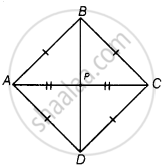Advertisements
Advertisements
प्रश्न
Students of a school are standing in rows and columns in their playground for a drill practice. A, B, C and D are the positions of four students as shown in figure. Is it possible to place Jaspal in the drill in such a way that he is equidistant from each of the four students A, B, C and D? If so, what should be his position?
उत्तर
Yes, from the figure we observe that the positions of four students A, B, C and D are (3, 5), (7, 9), (11, 5) and (7, 1) respectively i.e., these are four vertices of a quadrilateral.
Now, we will find the type of this quadrilateral.
For this, we will find all its sides.
We see that, AB = BC = CD = DA i.e., all sides are equal.
Now, AB = `sqrt((7 - 3)^2 + (9 - 5)^2` ...`["By distance formula", d = sqrt((x_2 - x_1)^2 + (y_2 - y_1)^2)]`
AB = `sqrt((4)^2 + (4)^2`
= `sqrt(16 + 16)`
AB = `4sqrt(2)`
BC = `sqrt((11 - 7)^2 + (5 - 9)^2`
= `sqrt((4)^2 + (-4)^2`
= `sqrt(16 + 16)`
= `4sqrt(2)`
CD = `sqrt((7 - 11)^2 + (1 - 5)^2`
= `sqrt((-4)^2 + (-4)^2`
= `sqrt(16 + 16)`
= `4sqrt(2)`
And DA = `sqrt((3 - 7)^2 + (5 - 1)^2`
= `sqrt((-4)^2 + (4)^2`
= `sqrt(16 + 16)`
= `4sqrt(2)`
We see that, AB = BC = CD = DA i.e., all sides are equal.
Now, we find length of both diagonals.
AC = `sqrt((11 - 3)^2 + (5 - 5)^2`
= `sqrt((8)^2 + 0)`
= 8
And BD = `sqrt((7 - 7)^2 + (1 - 9)^2`
= `sqrt(0 + (-8)^2`
= 8
Here, AC = BD
Since, AB = BC = CD = DA and AC = BD
Which represent a square.
Also known the diagonals of a square bisect each other.
So, P be position of Jaspal in which he is equidistant from each of the four students A, B, C and D.
∴ Coordinates of point P = Mid-point of AC
= `((3 + 11)/2, (5 + 5)/2)` ...`[∵ "Since, mid-point of a line segment having points" (x_1, y_1) "and" (x_2, y_2) = ((x_1 + y_1)/2, (x_2 + y_2)/2)]`
= `(14/2, 10/2)`
= (7, 5)
Hence, the required position of Jaspal is (7, 5).
APPEARS IN
संबंधित प्रश्न
On which axis do the following points lie?
Q(0, -2)
A (3, 2) and B (−2, 1) are two vertices of a triangle ABC whose centroid G has the coordinates `(5/3,-1/3)`Find the coordinates of the third vertex C of the triangle.
Show that the points A(5, 6), B(1, 5), C(2, 1) and D(6,2) are the vertices of a square.
Find the value of x such that PQ = QR where the coordinates of P, Q and R are (6, -1), (1, 3) and (x, 8) respectively.
Find the points of trisection of the line segment joining the points:
(3, -2) and (-3, -4)
Three consecutive vertices of a parallelogram are (-2,-1), (1, 0) and (4, 3). Find the fourth vertex.
Prove that (4, 3), (6, 4) (5, 6) and (3, 5) are the angular points of a square.
If the poin A(0,2) is equidistant form the points B (3, p) and C (p ,5) find the value of p. Also, find the length of AB.
Find the points on the y-axis which is equidistant form the points A(6,5) and B(- 4,3)
If the point P (2,2) is equidistant from the points A ( -2,K ) and B( -2K , -3) , find k. Also, find the length of AP.
If the point ( x,y ) is equidistant form the points ( a+b,b-a ) and (a-b ,a+b ) , prove that bx = ay
If (2, p) is the midpoint of the line segment joining the points A(6, -5) and B(-2,11) find the value of p.
ABCD is a rectangle whose three vertices are A(4,0), C(4,3) and D(0,3). Find the length of one its diagonal.
Show that ΔABC, where A(–2, 0), B(2, 0), C(0, 2) and ΔPQR where P(–4, 0), Q(4, 0), R(0, 2) are similar triangles.
If A(−3, 5), B(−2, −7), C(1, −8) and D(6, 3) are the vertices of a quadrilateral ABCD, find its area.
Write the perimeter of the triangle formed by the points O (0, 0), A (a, 0) and B (0, b).
The line segment joining the points A(2, 1) and B (5, - 8) is trisected at the points P and Q such that P is nearer to A. If P also lies on the line given by 2x - y + k= 0 find the value of k.
The coordinates of two points are P(4, 5) and Q(–1, 6). Find the difference between their abscissas.
The distance of the point (–6, 8) from x-axis is ______.
